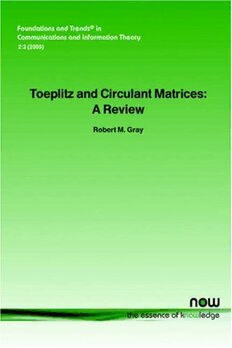
Toeplitz and circulant matrices - a review PDF
Preview Toeplitz and circulant matrices - a review
Toeplitz and Circulant Matrices: A review Toeplitz and Circulant Matrices: A review Robert M. Gray Deptartment of Electrical Engineering Stanford University Stanford 94305, USA [email protected] Contents Chapter 1 Introduction 1 Chapter 2 The Asymptotic Behavior of Matrices 5 2.1 Eigenvalues 5 2.2 Matrix Norms 8 2.3 Asymptotically Equivalent Matrices 11 2.4 Asymptotically Absolutely Equal Distributions 18 Chapter 3 Circulant Matrices 25 3.1 Eigenvalues and Eigenvectors 25 3.2 Properties 28 Chapter 4 Toeplitz Matrices 31 4.1 Bounded Toeplitz Matrices 31 4.2 Finite Order Toeplitz Matrices 36 4.3 Absolutely Summable Toeplitz Matrices 41 v vi CONTENTS 4.4 Unbounded Toeplitz Matrices 52 4.5 Inverses of Hermitian Toeplitz Matrices 53 4.6 Products of Toeplitz Matrices 57 4.7 Toeplitz Determinants 60 Chapter 5 Applications to Stochastic Time Series 63 5.1 Moving Average Processes 65 5.2 Autoregressive Processes 68 5.3 Factorization 70 5.4 Differential Entropy Rate of Gaussian Processes 73 Acknowledgements 75 References 77 Abstract t t t t 0 −1 −2 −(n−1) ··· t t t 1 0 −1 . . t t t . 2 1 0 ... ... t t n−1 ··· 0 The fundamental theorems on the asymptotic behavior of eigenval- ues, inverses, and products of “finite section” Toeplitz matrices and Toeplitz matrices with absolutely summable elements are derived in a tutorial manner. Mathematical elegance and generality are sacrificed for conceptual simplicity and insight in the hopes of making these re- sults available to engineers lacking either the background or endurance to attack the mathematical literature on the subject. By limiting the generality of the matrices considered the essential ideas and results can be conveyed in a more intuitive manner without the mathematical machinery required for the most general cases. As an application the results are applied to the study of the covariance matrices and their factors of linear models of discrete time random processes. vii 1 Introduction A Toeplitz matrix is an n n matrix T = t where t = t , i.e., n k,j k,j k−j × a matrix of the form t t t t 0 −1 −2 −(n−1) ··· t t t 1 0 −1 . . T = t t t . . (1.1) n 2 1 0 ... ... t t n−1 ··· 0 Examples of such matrices are covariance matrices of weakly station- ary stochastic time series and matrix representations of linear time- invariant discrete time filters. There are numerous other applications in mathematics, physics, information theory, estimation theory, etc. A great deal is known about the behavior of such matrices — the most common and complete references being Grenander and Szeg¨o [13] and Widom [29]. A more recent text devoted to the subject is B¨ottcher and Silbermann [4]. Unfortunately, however, the necessary level of math- ematical sophistication for understanding reference [13] is frequently beyond that of one species of applied mathematician for whom the theory can bequite usefulbutis relatively little understood.Thiscaste 1 2 Introduction consists of engineers doing relatively mathematical (for an engineer- ing background) work in any of the areas mentioned. This apparent dilemma provides the motivation for attempting a tutorial introduc- tion on Toeplitz matrices that proves the essential theorems using the simplest possible and most intuitive mathematics. Some simple and fundamental methods that are deeply buried (at least to the untrained mathematician) in [13] are here made explicit. Inadditiontothefundamentaltheorems,severalrelatedresultsthat naturally follow but do not appear to be collected together anywhere are presented. The essential prerequisites for this book are a knowledge of matrix theory, an engineer’s knowledge of Fourier series and random processes and calculus (Riemann integration). A first course in analysis would be helpful, but it is not assumed. Several of the occasional results re- quired of analysis are usually contained in one or more courses in the usual engineering curriculum, e.g., the Cauchy-Schwarz and triangle inequalities. Hopefully the only unfamiliar results are a corollary to the Courant-Fischer theorem and the Weierstrass approximation the- orem. The latter is an intuitive result which is easily believed even if not formally proved. More advanced results from Lebesgue integration, functional analysis, and Fourier series are not used. TheapproachofthisbookistorelatethepropertiesofToeplitzma- trices to those of their simpler, more structured cousin — the circulant or cyclic matrix. These two matrices are shown to be asymptotically equivalentinacertainsenseandthisisshowntoimplythateigenvalues, inverses, products, and determinants behave similarly. This approach provides a simplified and direct path (to the author’s point of view) to the basic eigenvalue distribution and related theorems. This method is implicit but not immediately apparent in the more complicated and more general results of Grenander in Chapter 7 of [13]. The basic re- sults for the special case of a finite order Toeplitz matrix appeared in [10], a tutorial treatment of the simplest case which was in turn based on the first draft of this work. The results were subsequently general- ized using essentially the same simple methods, but they remain less general than those of [13]. As an application several of the results are applied to study certain
